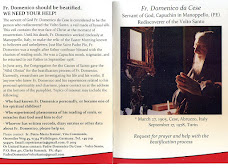About Blessed Kateri Tekakwitha
Mohawk (1656-1680)
from the website www.katerishrine.org
Kateri Shrine of Immaculate Conception Catholic Church
in Pawhuska, Oklahoma
Blessed Kateri Tekakwitha was born in 1656 in the Mohawk Indian Village at Ossernenon (now Auriesville in upstate New York) to a Mohawk chief and a Christian Algonquin mother.
Kateri was orphaned at the age of four when both her parents and her brother died in a smallpox plague. Kateri survived the disease, but it left her face badly scarred, her eyesight impaired, and delicate for the rest of her life. Kateri was adopted by her aunts and an uncle, a chief of the Mohawk Turtle clan who bitterly opposed Christianity. When she was about ten, the Turtle clan moved to the north bank of the Mohawk River, near what is now the town of Fonda, New York.
In 1667, the Jesuits missionaries Fremin, Bruyas, and Pierron, accompanying the Mohawk deputies who had been to Quebec to conclude peace with the French, spent three days in the lodge of Tekakwitha's uncle. Kateri received her first knowledge of Christianity from the Jesuits. When Kateri was eighteen, Father Jacques de Lamberville arrived to take charge of the Mohawk mission. Kateri secretly began instructions in the Christian faith. Her uncle finally relented and gave his consent for Kateri to become a Christian, provided that she did not try to leave the Indian village. Kateri received baptism from Father Jacques de Lamberville on Easter Sunday April 5, 1676. Kateri practiced her Christian faith unflinchingly in the face of almost unbearable opposition. The following year after being threatened because of her faith, she fled with the assistance of Christian Indians to the Mission of St. Francis Xavier, a settlement of Christian Indians in Canada on the St. Laurence, near Montréal. The village in Canada was also named Caughnawaga (Kahnawake). On Christmas Day 1677, Kateri made her first Holy Communion and on the Feast of the Annunciation in 1679 made a vow of perpetual virginity. She also offered herself to the Blessed Mother Mary to accept her as a daughter. Here she lived an ascetic life, winning the name Lily of the Mohawks for her charity, heroism, and piety. Kateri taught prayers to children and worked with the elderly and sick. She was known for her gentleness, kindness, and good humor.
During the last years of her life, Kateri endured great suffering from a serious illness. Kateri died on April 17, 1680 shortly before her 24th birthday at Caughnawaga, Canada. Witnesses at her deathbed, including Father Pierre Cholenec, reported Kateri’s face suddenly changed within fifteen minutes of her death. The pockmarks from smallpox completely vanished and her face shone with radiant loveliness. She was buried at Kahnawake, Quebec, Canada.
Upon her death, devotion to her began immediately to be manifested by her people. Several people, including a priest who attended Kateri during her last illness, reported that Kateri appeared to them and many healing miracles were attributed to her. Fifty years after Kateri's death the first convent for Indian nuns was established in Mexico and they pray daily for Sainthood for Blessed Kateri. Many pilgrims visit her grave in Caughnawaga where a monument to her memory was erected by the Rev. Clarence Walworth in 1884. Councils of Baltimore and Quebec have petitioned for her canonization.
Blessed Kateri Tekakwitha is the first Native North American and layperson recommended for canonization as a Saint in the Roman Catholic Church. Kateri was designated as Venerable in 1943 and was declared Blessed (beatified) on June 22, 1980by Pope John Paul II. Her feast day is celebrated on July 14th. If the Pope names Blessed Kateri a Saint, she will become the first Native American Saint in the Roman Catholic Church.
Subscribe to:
Post Comments (Atom)





No comments:
Post a Comment